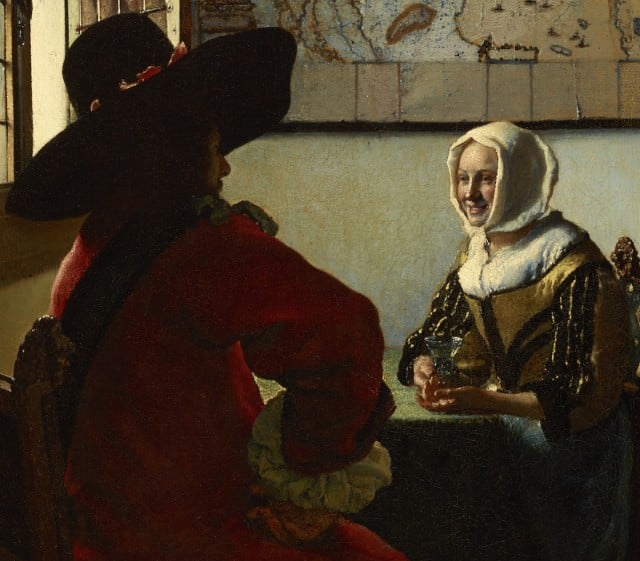Art & Exhibitions
Vermeer’s Light Dissolves Time and Space
THE DAILY PIC: The Dutch Master used light to make us ignore his foreignness.

THE DAILY PIC: The Dutch Master used light to make us ignore his foreignness.

Blake Gopnik


This is a detail from Johannes Vermeer’s Officer and Laughing Girl, in the Frick Collection in New York. I recently spent an hour looking at it with my pal Christian Viveros-Fauné, and those 60 minutes got distilled to their best five for the latest of our Strictly Critical videos at artnet News. (See “‘Strictly Critical’ Spends an Hour with Mr. Vermeer.”)
In the video, I complain that our 150-year-old taste for photography is what bred, and breeds, our relatively recent taste for Vermeer. This picture made in Golden Age Holland doesn’t seem to carry us back to its time and place; it leaves us safely in our own (post-)Kodak moment.
Maybe that is, in a sense, Vermeer’s fault. His perfect, proto-photographic simulation of space and light “naturalizes” everything else in his scene, so we take his painting as affording an utterly normal view into some perfectly normal place that just happens to be far away and long ago. The lady and soldier could as easily be us, in fancy dress. But as Christian and I spent our hour looking, a few details struck me as helping to return a deeper foreignness to the work, and to de-naturalize it for us.
The soldier, for one, must have been a very “marked” figure in Vermeer’s historical moment. We tend to see old-time warriors as splendid, harmless, Three Musketeers fare, but in the Netherlands in the 1650s, a figure like Vermeer’s must have evoked the rapine and slaughter his kind perpetrated amid the political chaos of 17th-century Europe. Imagine the same scene with a camo-wearing marine, and you’ll understand how it might have seemed to the burghers of Delft.
Then there’s the girl’s outstretched hand. After all these centuries, we may not be able to tell if her fingers are to be read as beckoning to the soldier, erotically, or waiting to be filled with gold. But one way or another, a human gesture like hers is too expressive, and intentional, to be read as meaningless. By inserting it into his picture, Vermeer encouraged decipherment of his puzzle—which means he was encouraging a reading that went beyond his naturalizing light and space. He may even have been defeating its claims to the natural.
If there’s one art-critical cliché I abhor more than others, it’s the invocation of universal human truths and the universal human condition. God save me from the universal in art: I want particulars from one time and place that is foreign to me, and that I can learn about. Vermeer’s light may simulate the universal, but in the end his subjects preserve the particular.
For a full survey of past Daily Pics visit blakegopnik.com/archive.